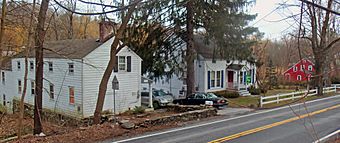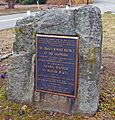Old Chappaqua Historic District facts for kids
Quick facts for kids |
|
|
Old Chappaqua Historic District
|
|

Tenant house, house and currying shop for the Samuel Allen Farm, 2013
|
|
| Location | Chappaqua, NY |
|---|---|
| Nearest city | White Plains |
| Area | 33 acres (13 ha) |
| Built | 1753–1850 |
| NRHP reference No. | 74001319 |
| Added to NRHP | July 15, 1974 |
The Old Chappaqua Historic District is a special area in New Castle, New York, United States. It is found along Quaker Road, between the small towns of Chappaqua and Millwood. This district was once the main center of Chappaqua. That was before the Harlem Valley Railroad was built in the mid-1800s, which moved the town's center south.
In 1974, this area was recognized as a historic district. This means it has important old buildings and history. It was then added to the National Register of Historic Places.
The Chappaqua area was first settled around 1740 by a group of Quakers from Long Island. They built the meeting house, which is still used today. It is the oldest known building in New Castle. The district grew around this meeting house about ten years later. The other old buildings in the district are from farms that were set up back then. These buildings have been kept very well over time.
Contents
Exploring the Old Chappaqua Historic District
The Old Chappaqua Historic District covers about 33 acres. It stretches along a 0.6-mile (1 km) part of Quaker Road. The area is quite hilly, with the road curving gently through it. Even though there are many homes, the district is very wooded. Tall trees provide lots of shade, and there are only a few open spaces.
Within this area, there are 30 buildings. About half of these are considered "contributing properties." This means they are old and important to the district's history. All the buildings, old and new, are made of wood. They are usually two or three stories tall with pointed roofs. Newer homes are built to look similar to the older, historic ones.
Except for the meeting house, all the buildings are still used as homes. In the middle of a small grassy area, there is a rock with a special plaque. This plaque remembers the historic district and its listing on the National Register of Historic Places.
A Look Back: History of Chappaqua's Old District
Quakers were a religious group who faced challenges in England. Many of them moved to British colonies in America in the 1600s. One Quaker group started a meeting on Long Island in 1645. By the early 1700s, some of their families moved across Long Island Sound to Westchester County. They started communities like Mamaroneck and Purchase by 1727.
How Chappaqua Began
Around 1730, more Quakers moved further inland. They settled near Wampus Pond (now Armonk) and a place called "Shapequaw." Ten years later, a Quaker named John Reynolds started a 100-acre farm in Shapequaw. This farm included the area that would become the historic district.
By 1747, enough Quakers lived in Shapequaw that they wanted their own meeting house. Permission was given, and John Reynolds gave two acres of his land for the meeting house and a burial ground.
The Meeting House and Early Life
The meeting house was finished by 1753. During the American Revolutionary War, in 1776, it was used as a hospital. Soldiers injured in the nearby Battle of White Plains were cared for there. Two years later, a new section was added to the meeting house.
John Reynolds' large farm was later divided into smaller pieces. Other farmers, like Samuel Allen and Elnathan Thorn, built their homes near the meeting house. By 1825, this area was known as Chappaqua. The people living there were mostly self-sufficient farmers. Many also had side jobs as craftsmen, making things by hand.
The Railroad Changes Everything
Life in Chappaqua changed when the Harlem Valley Railroad was built in 1846. The railroad followed the river valley, so the train station was built about a mile south of the meeting house. Slowly, that area around the station grew and became the downtown Chappaqua we know today.
Samuel Allen built some small houses across the road from the meeting house. A cabinetmaker named Henry Dodge built a large house at 386 Quaker Road. He even moved the older Thorn house to make space for his new home. This was some of the last building work done by the original Quaker families in the district.
As the railroad brought more people to northern Westchester, the meeting house and old farm buildings continued to be used. Farmers started growing cash crops to sell in New York City. They also sold some of their larger land areas.
Some buildings were damaged or destroyed by a tornado in 1904. However, new buildings added to the district did not replace any of the historic structures. In 1961, another section was added to the meeting house. Since then, there have been few changes to the very old buildings.
Important Historic Buildings
Several buildings in the Old Chappaqua Historic District are very important. While they are not listed individually on the National Register, they are local landmarks. They often have markers showing their name and when they were built.
- Samuel Allen Farm, 400, 401–407 Quaker Road. Four buildings from this farm still stand. They were all built by 1852. The currying shop (where leather was treated) is at 400 Quaker Road. There is also the main house, a tenant house, and an old barn. These buildings are similar, usually one-and-a-half to two stories tall.
- Thomas Dodge House, 428 Quaker Road. Thomas Dodge, a cabinetmaker, and his wife Hannah built this house. Because it's on a hill, it looks two stories tall on one side and one-and-a-half stories on the other.
- Meeting House, 420 Quaker Road. This building sits on a small hill above the road, next to the Allen properties. It is a two-story wooden building with a full porch around two sides. Inside, wooden posts support a balcony. This is the oldest known building in the town of New Castle, built in 1753.
- Reynolds–Carpenter Farmhouse, 332 Quaker Road. This large, two-story house is at the south end of the district. It was likely built for one of John Reynolds' seven sons. A back wing was added in 1850. North of the house is an old barn, now used as a garage.
- Stony Hollow Farmhouse, 478 Quaker Road. This house and barn are at the north end of the district. The house is made of wooden boards, while the barn has shingles. Both were likely built around 1820, and the house was made larger later in the 1800s.
- Sutton–Reynolds House, 354 Quaker Road. This house is similar in size to the Reynolds–Carpenter House. It is also believed to have been built by Reynolds for another of his sons. It stands out because of the two chimneys on each end of the house.
- Thorn–Dodge House, 386 Quaker Road. The back part of this two-story wooden house is the original building. It was built by Elnathan Thorn. Henry Dodge moved this older part when he built the main house in 1852.
Protecting Chappaqua's History
The town of New Castle works to protect and preserve the Old Chappaqua Historic District. Many of the historic properties in the district have been named "town landmarks."
The town has special rules for historic preservation. A Landmarks Advisory Committee helps the town decide which buildings are landmarks. This committee also guides how to protect buildings that are already landmarks. If an owner wants to change the outside of a landmark building, the committee must approve it first.
Owners of landmark buildings can also get tax breaks. This helps them pay for fixing up or improving their historic homes. The committee must approve the work beforehand, and a town official must confirm the work was done as planned.
Images for kids







